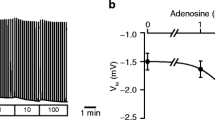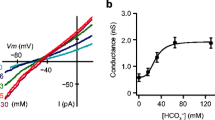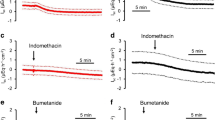Abstract
Whole-cell patch-clamp studies in base cells of isolated colonic crypts of rats pretreated with dexamethasone were performed to examine the effects of stimulation by forskolin (10 μmol/1). The experiments were designed in order to distinguish between two postulated effector mechanisms: the activation of a non-selective cation channel and the activation of Cl− channels. As shown in an accompanying report, forskolin depolarizes the membrane voltage (V m) by some 40–50 mV and enhances the whole-cell membrane conductance (G m) substantially in these cells. In this report all experiments were performed in the presence of forskolin. A reduction of the bath Na+ concentration from 145 to 2 mmol/1 led to a hyperpolarization ofV m by some 20–30 mV This hyperpolarization occurred very slowly suggesting that the hyperpolarization produced by the low-Na+ solution was caused indirectly and not by a change in the equilibrium potential for Na+,E Na +. A complete kinetic analysis of the effect on voltage of bath Na+ revealed a saturation-type relation with a high apparent affinity for Na+ of around 5–10 mmol/1. A reduction in bath Cl− concentration from 145 to 32 mmol/1 caused a depolarization ofV m from −34 ± 3 to −20 ± 4 mV (n = 13) in the presence of a high bath Na+ concentration, but had the opposite effect at low (5 mmol/1) Na+ concentrations:V m was hyperpolarized from −46 ± 4 to −62 ± 6 mV (n = 13). If the effect of Na+ onV m was caused by a non-selective cation channel the opposite would have been expected. To test directly whether the Na+2Cl−K+ cotransporter was responsible for the effects of changes in bath Na+ onV m, the effects of increasing concentrations of several loop diuretics were examined. Furosemide, piretanide, torasemide and burnetanide (up to 0.1–0.5 mmol/1) all hyperpolarizedV m, albeit only by less than 10 mV. Another subclass of loop diuretics containing a tetrazolate in position 1 [e.g. azosemide, no. 19A and no. 20A from Schlatter E, Greger R, Weidtke C (1983) Pflüger Arch 396: 210–217] were much more effective. Azosemide hyperpolarizedV m from −46 ± 3 to −74 ± 2 mV (n = 18) and reducedG m from 11 ± 1 to 4 ± 1 nS (n = 14). These data indicate that forskolin stimulates Cl− secretion in these cells by a mechanism fully compatible with the current scheme for exocrine secretion involving the Na+2Cl−K+ cotransporter.
Similar content being viewed by others
References
Böhme M, Diener M, Rummel W (1991) Calcium- and cyclic AMP-mediated secretory responses in isolated colonic crypts. Pflügers Arch 419:144–151
Diener M (1994) Segmental differences along the crypt axis in the response of cell volume to secretagogues or hypotonic medium in the rat colon. Pflügers Arch 426:462–464
Ecke D, Bleich M, Schwartz B, Fraser G, Greger R (1996) The ion conductances of dexamethasone-treated rat colonic crypts. Pflügers Arch 431:419–426
Field M, Rao MC, Chang EB (1989) Intestinal electrolyte transport and diarrheal disease. New Engl J Med 321:800–806
Gamba G, Miyanoshita A, Lombardi M, Lytton J, Lee WS, Hediger MA, Hebert SC (1994) Molecular cloning, primary structure, and characterization of two members of the mammalian electroneutral sodium-(potasium)chloride cotransporter family expressed in kidney. J Biol Chem 269:17713–17722
Greger R (1985) Ion transport mechanisms in thick ascending limb of Henle's loop of mammalian nephron. Physiol Rev 65:760–797
Greger R (1990) Chloride channel blockers. Methods Enzymol 191/5:793–810
Greger R, Schlatter E (1984) Mechanism of NaCl secretion in the rectal gland of spiny dogfish (Squalus acanthias). I. Experiments in isolated in vitro perfused rectal gland tubules. Pflügers Arch 402:63–75
Greger R, Schlatter E (1984) Mechanism of NaCl secretion in rectal gland tubules of spiny dogfish (Squalus acanthias). II. Effects of inhibitors. Pflügers Arch 402:364–375
Greger R, Schlatter E, Wang F, Forrest JNJ (1984) Mechanism of NaCl secretion in rectal gland tubules of spiny dogfish (Squalus acanthias). III. Effects of stimulation of secretion by cyclic AMP. Pflügers Arch 402:376–384
Greger R, Kunzelmann K, Gerlach L (1990) Mechanisms of chloride transport in secretory epithelia. Ann NY Acad Sci 6:403–415
Heintze K, Stewart CP, Frizzell RA (1983) Sodium-dependent chloride secretion across rabbit descending colon. Am J Physiol 244: G357-G365
Jørgensen PL (1992) Na, K-ATPase, structure and transport mechanism. In: de Pont HHJJM (ed) Molecular aspects of transport proteins. Elsevier, Amsterdam, pp 1–26
Kerst G, Fischer KG, Normann C, Kramer A, Leipziger J, Greger R (1995) Ca2+ influx induced by store release and cytosolic Ca2+ chelation in HT29 colon carcinoma cells. Pflügers Arch 430:653–665
Kunzelmann K, Tilmann M, Greger R 1992) Ion transport in HT29 colonic carcinoma cells. Adv Comp Environ Physiol 16:273–285
Lohrmann E, Greger R (1993) Isolated perfused rabbit colon crypts: stimulation of Cl− secretion by forskolin. Pflügers Arch 425:373–380
Lohrmann E, Greger R (1995) The effect of secretagogues on ion conductances of isolated in vitro perfused, isolated rabbit colonic crypts. Pflügers Arch 427:494–502
Loo DDF, Kaunitz JD (1989) Ca2+ and cAMP activated K+ channels in the basolateral membrane of crypt cells isolated from distal colon. J Membr Biol 110:19–28
Lukacs GL, Nanda A, Rotstein OD, Grinstein S (1991) The chloride channel blocker 5-nitro-2-(3-phenylpropyl-amino) benzoic acid (NPPB) uncouples mitochondria and increases the proton permeability of the plasma membrane in phagocytic cells. FEBS Lett 288:17–20
Payne JA, Forbush B (1994) Alternatively spliced isoforms of the putative renal Na-K-Cl cotransporter are differentially distributed within the rabbit kidney. Proc Natl Acad Sci USA 91:4544–4548
Reeves WB, Andreoli TE (1992) Renal epithelial chloride channels. Annu Rev Physiol 54:29–50
Sakmann B, Neher E (1984) Patch clamp techniques for studying ionic channels in excitable membranes. Annu Rev Physiol 46:455–472
Schlatter E, Greger R, Weidtke C (1983) Effect of “high ceiling” diuretics on active salt transport in the cortical thick ascending limb of Henlé's loop of rabbit kidney. Correlation of chemical structure and inhibitory potency. Pflügers Arch 396:210–217
Siemer C, Gögelein H (1992) Activation of non-selective cation channels in the basolateral membrane of rat distal colon crypt cells by prostaglandin E2, Pflügers Arch 420:319–328
Siemer C, Gögelein H (1993) Effect of forskolin on crypt cells of rat distal colon. Activation of non-selective cation channels in the crypt base and of chloride conductance in other parts of the crypt. Pflügers Arch 424:321–328
Wangemann P, Wittner M, Di Stefano A, Englert HC, Lang HJ, Schlatter E, Greger R (1986) Cl− channel blockers in the thick ascending limb of the loop of Henle. Structure activity relationship. Pflügers Arch 407 [Suppl 2]:S128-S141
Wiener H, van Os CH (1989) Rabbit distal colon epithelium: 11. characterization of Na− K+, Cl−-cotransport [3H]-bumetanide binding. J Membr Biol 110:163–174
Author information
Authors and Affiliations
Rights and permissions
About this article
Cite this article
Ecke, D., Bleich, M. & Greger, R. Crypt base cells show forskolin-induced Cl− secretion but no cation inward conductance. Pflugers Arch. 431, 427–434 (1996). https://doi.org/10.1007/BF02207282
Received:
Revised:
Accepted:
Issue Date:
DOI: https://doi.org/10.1007/BF02207282




